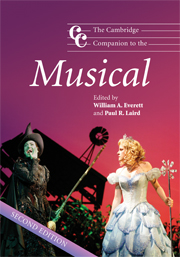Book contents
- Frontmatter
- Part I Adaptations and transformations: before 1940
- 1 American musical theatre before the twentieth century
- 2 Non-English-language musical theatre in the United States
- 3 Birth pangs, growing pains and sibling rivalry: musical theatre in New York, 1900–1920
- 4 American and British operetta in the 1920s: romance, nostalgia and adventure
- 5 Images of African Americans: African-American musical theatre, Show Boat and Porgy and Bess
- 6 The melody (and the words) linger on: American musical comedies of the 1920s and 1930s
- Part II Maturations and formulations: 1940–1970
- Part III Evolutions and integrations: after 1970
- Part IV Legacies and transformations
- Notes
- Select bibliography
- Index
6 - The melody (and the words) linger on: American musical comedies of the 1920s and 1930s
from Part I - Adaptations and transformations: before 1940
Published online by Cambridge University Press: 28 September 2011
- Frontmatter
- Part I Adaptations and transformations: before 1940
- 1 American musical theatre before the twentieth century
- 2 Non-English-language musical theatre in the United States
- 3 Birth pangs, growing pains and sibling rivalry: musical theatre in New York, 1900–1920
- 4 American and British operetta in the 1920s: romance, nostalgia and adventure
- 5 Images of African Americans: African-American musical theatre, Show Boat and Porgy and Bess
- 6 The melody (and the words) linger on: American musical comedies of the 1920s and 1930s
- Part II Maturations and formulations: 1940–1970
- Part III Evolutions and integrations: after 1970
- Part IV Legacies and transformations
- Notes
- Select bibliography
- Index
Summary
Setting the stage
The period under surveillance in this chapter divides with discomforting accuracy into two vastly contrasting national moods. America in the 1920s, retrospectively tagged as the Jazz Age (from F. Scott Fitzgerald's 1931 essay, ‘Echoes of the Jazz Age’), the Roaring Twenties or, more euphemistically, Prohibition, experienced a decade of unprecedented prosperity and self confidence. Republican presidents, for whom the business of America was business, led the country. Immigration, which had in the previous generation brought the parents of future songwriters to America, came to a virtual halt, and isolationism reigned as the prevailing sentiment. Women voted for the first time in the election of 1920 and the Smart Set began to explore social freedoms as well, such as public smoking, reading sex and confession magazines, applying make-up, bobbing their hair and wearing short skirts. As further manifestation of what contemporary social historian Frederick Lewis Allen called ‘a revolution in manners and morals’, both men and women sharply increased their alcohol consumption, imbibing in thousands of newly sprouting metropolitan speakeasies in Prohibition America. By the end of the decade radio became a family ritual, and sound films revolutionised an already popular entertainment and created new opportunities for musicals, both adapted from the stage and original. The 1920s introduced an exceptional generation of American playwrights (Eugene O'Neill, Maxwell Anderson), novelists (Sinclair Lewis, Ernest Hemingway, Fitzgerald), classical composers (Edgard Varèse, Aaron Copland) and jazz artists (Louis Armstrong, Duke Ellington).
- Type
- Chapter
- Information
- The Cambridge Companion to the Musical , pp. 103 - 124Publisher: Cambridge University PressPrint publication year: 2008
- 1
- Cited by



